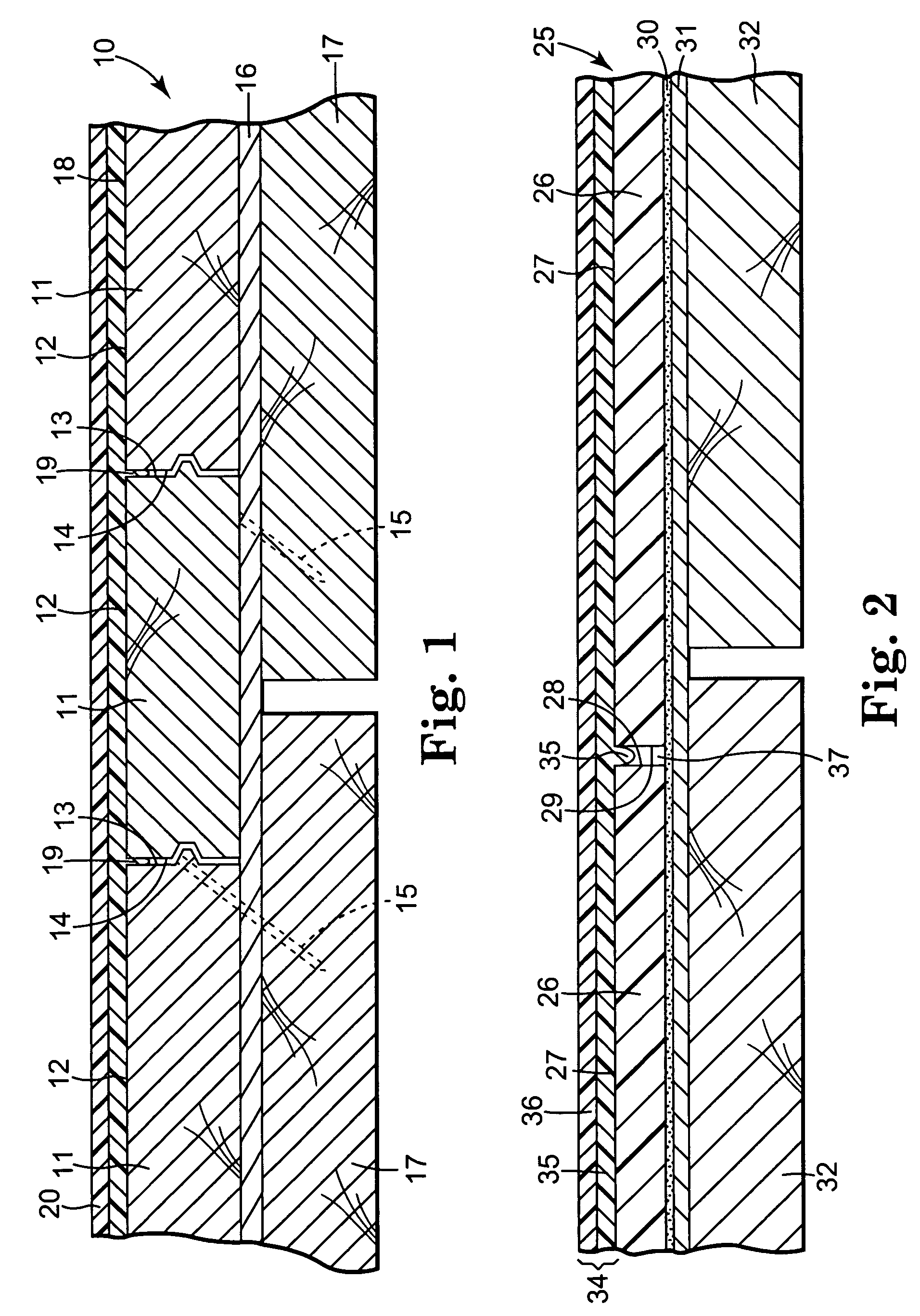Jobsite-renewable multilayer floor finish with enhanced hardening rate
a multi-layer floor finish and enhanced hardening technology, applied in the direction of polishing compositions, transportation and packaging, synthetic resin layered products, etc., can solve the problems of reducing pot life, unacceptably slow hardening rate or unacceptably long tack-free time, etc., to achieve good durability, high crosslink density, and good wear resistance
- Summary
- Abstract
- Description
- Claims
- Application Information
AI Technical Summary
Benefits of technology
Problems solved by technology
Method used
Image
Examples
example 1
[0056]Undercoat No. 2 was applied with and without an added topcoat initiator to vinyl composition tiles cleaned as described above. The undercoat became dry to the touch within about 30 minutes, and was allowed to dry for a further 90 minutes prior to topcoat application to ensure complete dryness. Run No. 1-1 had no topcoat initiator in the undercoat or topcoat. In Run No. 1-2, a topcoat initiator (NanoTek™ aqueous zinc oxide dispersion, 52%, commercially available from Nanophase Technologies Corporation, and identified below as “ZnO”) was added to Undercoat No. 2 prior to coating with Topcoat No. 4. In Run no. 1-3, the same topcoat initiator was stirred into Part A of Topcoat No. 4 before Part A was mixed with Part B. The tack-free times for the coated tiles were determined using Evaluation Method 2. The pot life times for the topcoat coating solutions were determined as described above. The results are shown below in Table 3.
[0057]
TABLE 3UndercoatTopcoatResultsRunInitiatorInitia...
example 2
[0059]Using the method of Example 1 and various undercoat drying times, dibutyltin bis(1-thioglycerol) (FASCAT™ 4224, commercially available from Atofina Chemicals, Inc. and identified below as “F4224”) was evaluated as a topcoat initiator in Undercoat No. 2 and coated with Topcoat No. 1. The initiator concentration (reported as the wt. % of FASCAT 4224 in the coating solution), topcoat tack-free times and solution pot lives are shown below in Table 4.
[0060]
TABLE 4UndercoatTopcoatResultsRunInitiatorDryingInitiatorTack-Free Time,Topcoat PotNo.InitiatorIdentityConc., %Time, minIdentityConc., %hours:MinLife, hours:Min2-1NoneNo. 2060No. 107:302:302-2NoneNo. 20160No. 107:302:372-3F4224No. 21.5160No. 107:302:372-4F4224No. 22.515No. 104:30N.D.*2-5F4224No. 22.460No. 105:00N.D.*2-6F4224No. 22.5960No. 107:002:452-7F4224No. 2060No. 10.074:300:592-8F4224No. 2060No. 10.153:000:23*N.D. = Not Determined
[0061]The results in Table 4 demonstrate that adding dibutyltin bis(1-thioglycerol to the underc...
example 3
[0065]Using the general method of Example 1 but with overnight drying of the second layer of Undercoat No. 1 before application of the first layer of Topcoat No. 3, zinc tetraamine carbonate (15% zinc (as ZnO), CAS 38714-47-5, low pH version containing about 12-16% ammonia, commercially available from ChemCor and identified by the manufacturer as “zinc ammonium carbonate” and identified below as “ZTC”) was evaluated as a topcoat initiator. The initiator concentrations in the undercoat (reported as the equivalent wt. % of zinc oxide) and the topcoat tack-free times are shown below in Table 6.
[0066]
TABLE 6InitiatorConc. InTack-freeUnderUndercoat,ToptimeRun No.Initiatorcoat%coat(hours:min)3-1NoneNo. 10.0No. 37:003-2ZTCNo. 10.11No. 37:303-3ZTCNo. 10.72No. 35:003-4ZTCNo. 11.6No. 34:00
[0067]The results in Table 6 demonstrate that adding zinc tetraamine carbonate initiator to the undercoat could substantially reduce the topcoat tack-free time (compare Run No. 3-1 to Run Nos. 3-3 and 3-4). ...
PUM
| Property | Measurement | Unit |
|---|---|---|
| particle diameter | aaaaa | aaaaa |
| particle diameter | aaaaa | aaaaa |
| thickness | aaaaa | aaaaa |
Abstract
Description
Claims
Application Information
 Login to View More
Login to View More - R&D
- Intellectual Property
- Life Sciences
- Materials
- Tech Scout
- Unparalleled Data Quality
- Higher Quality Content
- 60% Fewer Hallucinations
Browse by: Latest US Patents, China's latest patents, Technical Efficacy Thesaurus, Application Domain, Technology Topic, Popular Technical Reports.
© 2025 PatSnap. All rights reserved.Legal|Privacy policy|Modern Slavery Act Transparency Statement|Sitemap|About US| Contact US: help@patsnap.com

